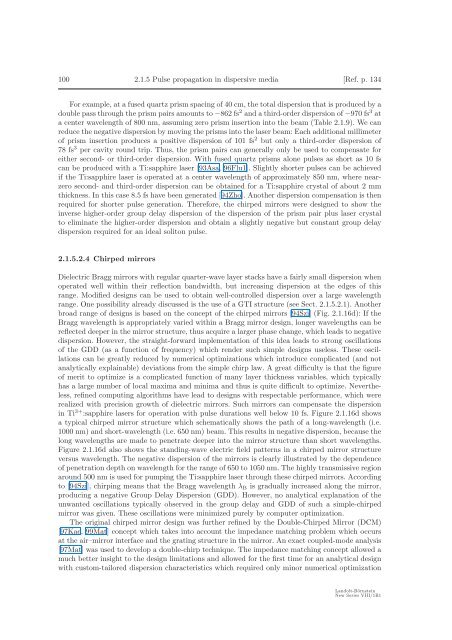2.1 Ultrafast solid-state lasers - ETH - the Keller Group
2.1 Ultrafast solid-state lasers - ETH - the Keller Group
2.1 Ultrafast solid-state lasers - ETH - the Keller Group
Create successful ePaper yourself
Turn your PDF publications into a flip-book with our unique Google optimized e-Paper software.
100 <strong>2.1</strong>.5 Pulse propagation in dispersive media [Ref. p. 134<br />
For example, at a fused quartz prism spacing of 40 cm, <strong>the</strong> total dispersion that is produced by a<br />
double pass through <strong>the</strong> prism pairs amounts to −862 fs 2 and a third-order dispersion of −970 fs 3 at<br />
a center wavelength of 800 nm, assuming zero prism insertion into <strong>the</strong> beam (Table <strong>2.1</strong>.9). We can<br />
reduce <strong>the</strong> negative dispersion by moving <strong>the</strong> prisms into <strong>the</strong> laser beam: Each additional millimeter<br />
of prism insertion produces a positive dispersion of 101 fs 2 but only a third-order dispersion of<br />
78 fs 3 per cavity round trip. Thus, <strong>the</strong> prism pairs can generally only be used to compensate for<br />
ei<strong>the</strong>r second- or third-order dispersion. With fused quartz prisms alone pulses as short as 10 fs<br />
can be produced with a Ti:sapphire laser [93Asa, 96Flu1]. Slightly shorter pulses can be achieved<br />
if <strong>the</strong> Ti:sapphire laser is operated at a center wavelength of approximately 850 nm, where nearzero<br />
second- and third-order dispersion can be obtained for a Ti:sapphire crystal of about 2 mm<br />
thickness. In this case 8.5 fs have been generated [94Zho]. Ano<strong>the</strong>r dispersion compensation is <strong>the</strong>n<br />
required for shorter pulse generation. Therefore, <strong>the</strong> chirped mirrors were designed to show <strong>the</strong><br />
inverse higher-order group delay dispersion of <strong>the</strong> dispersion of <strong>the</strong> prism pair plus laser crystal<br />
to eliminate <strong>the</strong> higher-order dispersion and obtain a slightly negative but constant group delay<br />
dispersion required for an ideal soliton pulse.<br />
<strong>2.1</strong>.5.2.4 Chirped mirrors<br />
Dielectric Bragg mirrors with regular quarter-wave layer stacks have a fairly small dispersion when<br />
operated well within <strong>the</strong>ir reflection bandwidth, but increasing dispersion at <strong>the</strong> edges of this<br />
range. Modified designs can be used to obtain well-controlled dispersion over a large wavelength<br />
range. One possibility already discussed is <strong>the</strong> use of a GTI structure (see Sect. <strong>2.1</strong>.5.<strong>2.1</strong>). Ano<strong>the</strong>r<br />
broad range of designs is based on <strong>the</strong> concept of <strong>the</strong> chirped mirrors [94Szi] (Fig. <strong>2.1</strong>.16d): If <strong>the</strong><br />
Bragg wavelength is appropriately varied within a Bragg mirror design, longer wavelengths can be<br />
reflected deeper in <strong>the</strong> mirror structure, thus acquire a larger phase change, which leads to negative<br />
dispersion. However, <strong>the</strong> straight-forward implementation of this idea leads to strong oscillations<br />
of <strong>the</strong> GDD (as a function of frequency) which render such simple designs useless. These oscillations<br />
can be greatly reduced by numerical optimizations which introduce complicated (and not<br />
analytically explainable) deviations from <strong>the</strong> simple chirp law. A great difficulty is that <strong>the</strong> figure<br />
of merit to optimize is a complicated function of many layer thickness variables, which typically<br />
has a large number of local maxima and minima and thus is quite difficult to optimize. Never<strong>the</strong>less,<br />
refined computing algorithms have lead to designs with respectable performance, which were<br />
realized with precision growth of dielectric mirrors. Such mirrors can compensate <strong>the</strong> dispersion<br />
in Ti 3+ :sapphire <strong>lasers</strong> for operation with pulse durations well below 10 fs. Figure <strong>2.1</strong>.16d shows<br />
a typical chirped mirror structure which schematically shows <strong>the</strong> path of a long-wavelength (i.e.<br />
1000 nm) and short-wavelength (i.e. 650 nm) beam. This results in negative dispersion, because <strong>the</strong><br />
long wavelengths are made to penetrate deeper into <strong>the</strong> mirror structure than short wavelengths.<br />
Figure <strong>2.1</strong>.16d also shows <strong>the</strong> standing-wave electric field patterns in a chirped mirror structure<br />
versus wavelength. The negative dispersion of <strong>the</strong> mirrors is clearly illustrated by <strong>the</strong> dependence<br />
of penetration depth on wavelength for <strong>the</strong> range of 650 to 1050 nm. The highly transmissive region<br />
around 500 nm is used for pumping <strong>the</strong> Ti:sapphire laser through <strong>the</strong>se chirped mirrors. According<br />
to [94Szi], chirping means that <strong>the</strong> Bragg wavelength λ B is gradually increased along <strong>the</strong> mirror,<br />
producing a negative <strong>Group</strong> Delay Dispersion (GDD). However, no analytical explanation of <strong>the</strong><br />
unwanted oscillations typically observed in <strong>the</strong> group delay and GDD of such a simple-chirped<br />
mirror was given. These oscillations were minimized purely by computer optimization.<br />
The original chirped mirror design was fur<strong>the</strong>r refined by <strong>the</strong> Double-Chirped Mirror (DCM)<br />
[97Kae, 99Mat] concept which takes into account <strong>the</strong> impedance matching problem which occurs<br />
at <strong>the</strong> air–mirror interface and <strong>the</strong> grating structure in <strong>the</strong> mirror. An exact coupled-mode analysis<br />
[97Mat] was used to develop a double-chirp technique. The impedance matching concept allowed a<br />
much better insight to <strong>the</strong> design limitations and allowed for <strong>the</strong> first time for an analytical design<br />
with custom-tailored dispersion characteristics which required only minor numerical optimization<br />
Landolt-Börnstein<br />
New Series VIII/1B1
















